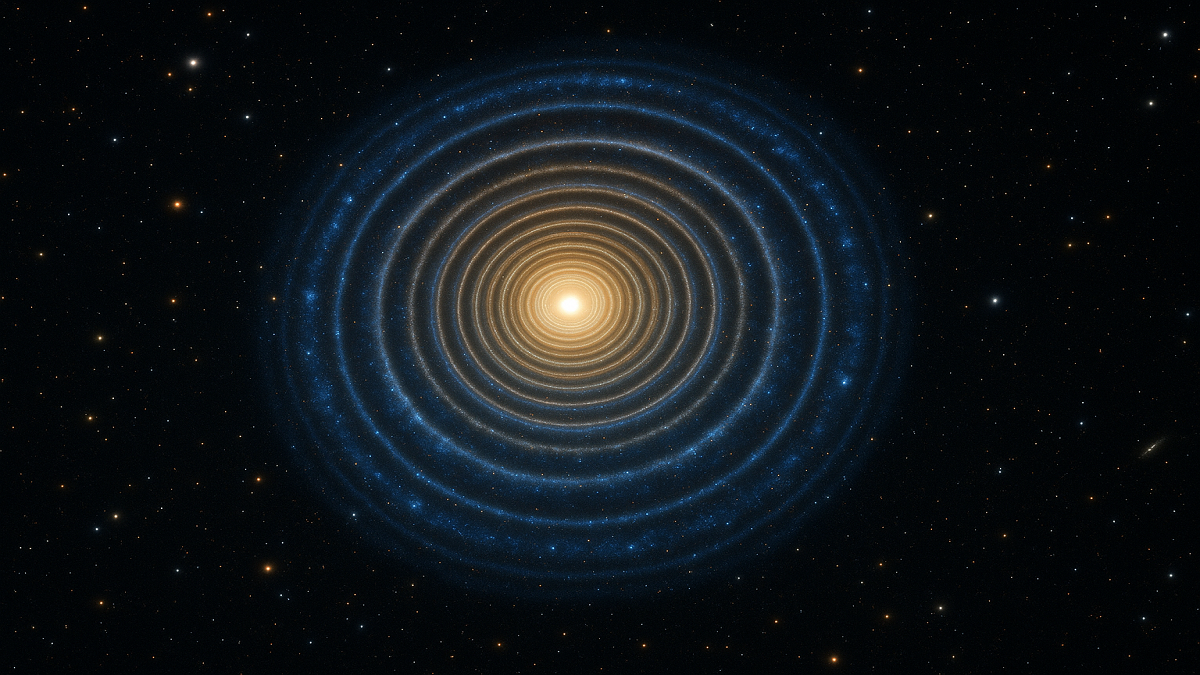In the vast cosmos, galaxies come in various shapes and sizes, but few captivate astronomers like LEDA 1313424, more famously known as the Bullseye Galaxy. Discovered by an international team of researchers, this extraordinary galaxy, located 567 million light-years away in the Pisces constellation, presents a never-before-seen phenomenon — nine glowing star rings, the most ever observed around a single galaxy.
Basic Facts About the Bullseye Galaxy
The Bullseye Galaxy is a giant elliptical galaxy, approximately 2.5 times larger than our own Milky Way, boasting a diameter of about 250,000 light-years. What makes it uniquely fascinating is not just its size but the spectacular rings of stars that encircle its core, giving it a structure resembling a cosmic bullseye.
These rings are believed to have formed after a violent galactic collision, where a smaller blue dwarf galaxy plunged straight through the Bullseye’s center nearly 50 million years ago. This high-energy event set off a ripple-like effect, compressing gas and sparking waves of new star formation — ultimately creating the distinct rings.
Why Are the Rings So Special?
In typical ring galaxies, astronomers might observe one or two rings, sometimes three. The Bullseye Galaxy, however, features nine distinct stellar rings, an unprecedented number that sets it apart in galactic studies.
- NASA’s Hubble Space Telescope first detected eight rings, capturing the inner cosmic structure in stunning detail.
- The W.M. Keck Observatory in Hawaii later confirmed a ninth outer ring, expanding the known boundary of this celestial wonder.
- Some researchers speculate that a tenth ring may have existed, but it likely faded over time or became too diffuse to observe with current technology.
Each ring, glowing with freshly formed stars, moves either inward or outward, indicating dynamic galactic processes at play.
The Role of Galactic Collisions in Ring Formation
The ring structures are direct evidence of galactic collisions and interactions, key drivers in galaxy evolution. When the dwarf galaxy struck LEDA 1313424, the collision:
- Compressed vast clouds of gas, triggering star formation in expanding waves.
- Sent material radiating outward from the center, forming symmetrical ring patterns.
- Set off density waves, much like ripples in a pond, that sculpted the galaxy into its current form.
This makes the Bullseye Galaxy a natural laboratory for understanding how galaxies morph and grow over time.
A Window into Dark Matter Mysteries
Perhaps even more intriguing is how the Bullseye Galaxy offers a rare opportunity to study dark matter, the elusive substance that constitutes about 30% of the universe’s mass-energy. Although dark matter cannot be seen, it reveals itself through gravitational effects on visible matter.
How the Rings Help
The rings of the Bullseye Galaxy function as tracers, helping astronomers map how dark matter is distributed around and within galaxies. Because the motion and structure of these rings are influenced by the gravitational pull of both visible and invisible mass, they provide crucial data for:
- Testing theories of how dark matter behaves.
- Understanding how galaxies are held together by gravitational forces.
- Observing how dark matter shapes the formation and structure of galaxies over cosmic timescales.
The Bullseye Galaxy’s unique ring system may ultimately help confirm or challenge existing models of dark matter dynamics.



 ISRO Launches RESPOND Basket 2025, Calls...
ISRO Launches RESPOND Basket 2025, Calls...
 LVM3-M6 Rocket Set to Launch on December...
LVM3-M6 Rocket Set to Launch on December...
 Michaela Benthaus to Make History as Fir...
Michaela Benthaus to Make History as Fir...







